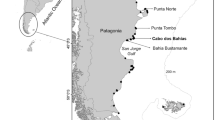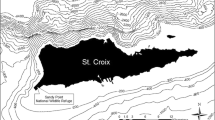Abstract
Fifteen yellow-bellied sea snakes,Pelamis platurus, fitted with pressure-sensitive ultrasonic transmitters, were tracked in the Gulf of Panamá during 1983–1985. Snakes spent up to 99.9% (\(\bar x\) = 87%) of the tracking time under water and dived to 50 m. The maximum voluntary submergence time observed was 213 min, and of 202 complete dives logged, 19 exceeded 90 min. Dive durations of tracked snakes were typically longer than expected, based upon their estimated body-oxygen stores, and some were even longer than the reported survival times of forceably submerged snakes. Snakes, however, dived repeatedly and did not spend long periods at the surface between dives, suggesting that they did not develop an oxygen deficit during diving. Diving snakes may be able to avoid anaerobiosis by having a reduced metabolic rate, an enhanced rate of cutaneous oxygen uptake, or both. Surface conditions and subsurface temperatures influence the diving behavior ofP. platurus. Laboratory experiments in Panamá indicated that a larger number of snakes were submerged when surface water was turbulent. During February and March, the period of dry season upwelling in the Gulf of Panamá, sea snakes were found to avoid cooler, subsurface water and to make significantly shallower dives: mean maximum depth 6:8 m (n=76) in contrast to a mean maximum depth of 15.1 m (n=147) during the wet season. The dives during the dry season tended to be of shorter duration, with 44% lasting less than 15 min, compared to only 19% of the dives recorded during the wet season being completed in less than 15 min. General avoidance of subsurface temperatures cooler than 19°C was confirmed by laboratory experiments in the 10 m-deep tank at Scripps Institution of Oceanography.
Similar content being viewed by others
Literature cited
Andersen, H. T.: Physiological adaptations in diving vertebrates. Physiol. Rev.46, 212–243 (1966)
Dunson, W. A. and G. W. Ehlert: Effects of temperature, salinity, and surface flow on distribution of the sea snakePelamis. Limnol. Oceanogr.16, 845–853 (1971)
Glynn, P. W.: Observations on the ecology of the Caribbean and Pacific coast of Panamá. Bull. biol. Soc. Wash.1972 (2), 13–30 (1972)
Graham, J. B.: Aquatic respiration and the physiological responses to submersion of the sea snakePelamis platurus. Am. Zool.13, p. 221 (Abstract) (1973)
Graham, J. B.: Aquatic respiration in the sea snakePelamis platurus. Respir. Physiol.21, 1–7 (1974)
Graham, J. B., J. H. Gee and F. S. Robison: Hydrostatic and gas exchange functions of the lung of the sea snakePelamis platurus. Comp. Biochem. Physiol.50A, 477–482 (1975)
Graham, J. B., I. Rubinoff and M. K. Hecht: Temperature physiology of the sea snakePelamis platurus: an index of its colonization potential in the Atlantic Ocean. Proc. natn. Acad. Sci. USA.68, 1360–1363 (1971)
Heatwole, H.: Voluntary submergence times of marine snakes. Mar. Biol.32, 205–213 (1975)
Heatwole, H.: Adaptations of marine snakes. Am. Scient.66, 594–604 (1978)
Heatwole, H., S. A. Minton, R. Taylor and V. Taylor: Underwater observations on sea snake behavior. Rec. Aust. Mus.31, 737–761 (1978)
Heatwole, H. and R. Seymour: Diving physiology.In: The biology of sea snakes, pp 289–327. Ed. by W. A. Dunson. Baltimore: University Park Press 1975
Hicks, C. R.: Fundamental concepts in the design of experiments, 425 pp. New York: Holt, Rinehart & Winston 1982
Kropach, C.: A field study of the sea snakePelamis platurus (Linnaeus) in the Gulf of Panamá, 200 pp. Ph. D. dissertation, The City University of New York 1973
Kropach, C.: The yellow-bellied sea snakePelamis in the eastern Pacific.In: The biology of sea snakes, pp 185–213. Ed. by W. A. Dunson. Baltimore: University Park Press 1975
McCosker, J. E.: Feeding behavior of Indo-Australian hydrophiidae.In: The biology of sea snakes, pp 217–232. Ed. by. W. A. Dunson. Baltimore: University Park Press 1975
Pickwell, G. V.: The venomous sea snakes. Fauna (Zool. Mag.)4, 17–32 (1972)
Pough, F. H. and H. B. Lillywhite: Blood volume and blood oxygen capacity of sea snakes. Physiol. Zoöl.57, 32–39 (1984)
Rubinoff, I. and C. Kropach: Differential reactions of Atlantic and Pacific predators to sea snakes. Nature, Lond.228 (5278), 1288–1290 (1970)
Scholander, P. F.: Physiological adaptations to diving in animals and man. Harvey Lect.57, 93–110 (1962)
Seymour, R. S.: How sea snakes may avoid the bends. Nature, Lond.250, 489–490 (1974)
Seymour, R. S.: Physiological adaptations to aquatic life.In: Biology of the Reptilia, Vol. 14. pp 1–51. Ed. by C. Gans and F. H. Pough. London: Academic Press 1982
Smayda, T. J.: A quantitative analysis of the phytoplankton of the Gulf of Panamá. III. General ecological conditions and the phytoplankton dynamics at 8°45′N, 79°23′W from November 1954 to May 1957. Bull. inter-Am. trop. Tuna Commn11, 353–612 (1966)
Tu, A. T.: Investigations of the sea snake,Pelamis platurus (Reptilia, Serpentes, Hydrophiidae), on the Pacific coast of Costa Rica, Central America. J. Herpetol.10, 13–18 (1976)
Voris, H. K. and H. H. Voris: Feeding strategies in marine snakes: an analysis of evolutionary, morphological, behavioral and ecological relationships. Am. Zool.23, 411–425 (1983)
Author information
Authors and Affiliations
Additional information
Communicated by R. S. Carney, Moss Landing
Rights and permissions
About this article
Cite this article
Rubinoff, I., Graham, J.B. & Motta, J. Diving of the sea snakePelamis platurus in the Gulf of Panamá. Mar. Biol. 91, 181–191 (1986). https://doi.org/10.1007/BF00569434
Accepted:
Issue Date:
DOI: https://doi.org/10.1007/BF00569434




